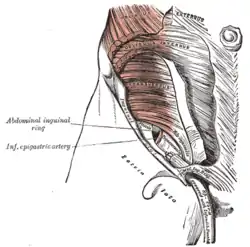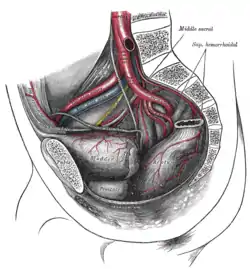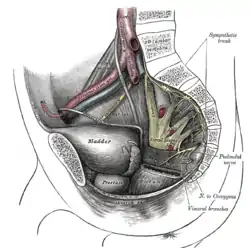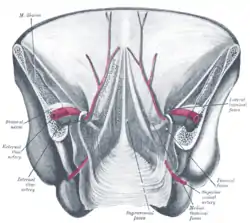Inferior epigastric artery
In human anatomy, inferior epigastric artery refers to the artery that arises from the external iliac artery. It anastomoses with the superior epigastric artery. Along its course, it is accompanied by a similarly named vein, the inferior epigastric vein. These epigastric vessels form the lateral border of Hesselbach's triangle, which outlines the area through which direct inguinal hernias protrude.
| Inferior epigastric artery | |
|---|---|
 Right inferior epigastric artery - view from inside of abdomen. (Inferior epigastric vessels labeled at upper left.) | |
 The abdominal inguinal ring. (Inf. epigastric artery labeled at center left.) | |
| Details | |
| Source | external iliac artery |
| Branches | cremasteric artery, pubic branch of inferior epigastric artery, artery of round ligament of uterus ♀ |
| Vein | inferior epigastric vein |
| Identifiers | |
| Latin | arteria epigastrica inferior |
| TA98 | A12.2.16.003 |
| TA2 | 4358 |
| FMA | 20686 |
| Anatomical terminology | |
Structure
The inferior epigastric artery arises from the external iliac artery, immediately above the inguinal ligament.[1] It anastomoses with the superior epigastric artery.[1]
It curves forward in the subperitoneal tissue, and then ascends obliquely along the medial margin of the abdominal inguinal ring; continuing its course upward, it pierces the transversalis fascia, and, passing in front of the linea semicircularis, ascends between the rectus abdominis muscle and the posterior lamella of its sheath.
It finally divides into numerous branches, which anastomose, above the umbilicus, with the superior epigastric branch of the internal thoracic artery and with the lower intercostal arteries.
As the inferior epigastric artery passes obliquely upward from its origin it lies along the lower and medial margins of the abdominal inguinal ring, and behind the commencement of the spermatic cord.
The vas deferens, as it leaves the spermatic cord in the male, and the round ligament of the uterus in the female, winds around the lateral and posterior aspects of the artery.
Clinical significance
Hernia
The inferior epigastric artery may lie close to an inguinal hernia, so acts as a useful landmark.[2]
Surgery
The inferior epigastric artery may be damaged during laparoscopic surgery.[2] It may also be damaged when manually finding the peritoneum beneath the rectus abdominis muscle.[2]
Additional images
 The interfoveolar ligament, seen from in front.
The interfoveolar ligament, seen from in front. The internal mammary artery and its branches.
The internal mammary artery and its branches. The arteries of the pelvis.
The arteries of the pelvis. The iliac veins.
The iliac veins. Dissection of side wall of pelvis showing sacral and pudendal plexuses.
Dissection of side wall of pelvis showing sacral and pudendal plexuses. Posterior view of the anterior abdominal wall in its lower half. The peritoneum is in place, and the various cords are shining through.
Posterior view of the anterior abdominal wall in its lower half. The peritoneum is in place, and the various cords are shining through. Front of abdomen, showing surface markings for arteries and inguinal canal.
Front of abdomen, showing surface markings for arteries and inguinal canal. Schema of the arteries arising from the external iliac and femoral arteries.
Schema of the arteries arising from the external iliac and femoral arteries.
References
This article incorporates text in the public domain from page 623 of the 20th edition of Gray's Anatomy (1918)
- Castro Ferreira, Marcus; Henrique Ishida, Luis; Munhoz, Alexandre (January 1, 2009), Wei, Fu-Chan; Mardini, Samir (eds.), "CHAPTER 19 - Rectus flap", Flaps and Reconstructive Surgery, Edinburgh: W.B. Saunders, pp. 207–223, ISBN 978-0-7216-0519-7, retrieved January 22, 2021
- Paterson-Brown, Sara (January 1, 2010), Bennett, Phillip; Williamson, Catherine (eds.), "Chapter Five - Applied anatomy", Basic Science in Obstetrics and Gynaecology (Fourth Edition), Churchill Livingstone, pp. 57–95, doi:10.1016/b978-0-443-10281-3.00009-9, ISBN 978-0-443-10281-3, retrieved January 22, 2021
External links
- Anatomy figure: 35:04-07 at Human Anatomy Online, SUNY Downstate Medical Center - "Incisions and the contents of the rectus sheath."
- Anatomy photo:35:12-0104 at the SUNY Downstate Medical Center - "Anterior Abdominal Wall: Blood Vessels in the Rectus sheath"
- Anatomy image:7282 at the SUNY Downstate Medical Center
- Anatomy image:7326 at the SUNY Downstate Medical Center
- Anatomy image:7542 at the SUNY Downstate Medical Center
- Anatomy image:7578 at the SUNY Downstate Medical Center
- figures/chapter_25/25-9.HTM: Basic Human Anatomy at Dartmouth Medical School